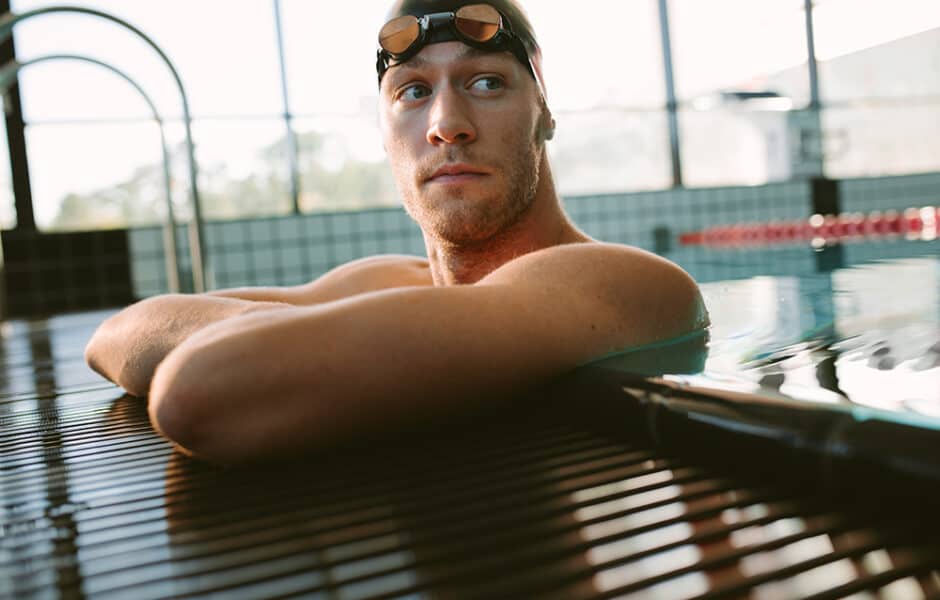Hidden Reality Of Professional Swimmer Wages: From Pool To Paycheck

While Roger Federer earned a staggering $106 million in 2020 as the world’s highest-paid athlete, professional swimmer wages tell a dramatically different story. The financial reality for those who dedicate their lives to competitive swimming is surprisingly modest.
In fact, the average pro swimmer makes less than 1% of what professional basketball or football players earn. This stark disparity raises questions about how much professional swimmers actually make. Even top-tiered swimmers only bring in approximately $30,000 annually, despite years of rigorous training and world-class performances. Olympic success, though prestigious, doesn’t necessarily translate to financial stability—winning a gold medal at the Olympics nets American swimmers around $20,000.
The professional swimming salary landscape varies dramatically by country. At the 2016 Rio Olympics, medal bonuses ranged from absolutely nothing in the United Kingdom to $25,000 for American gold medalists. Meanwhile, countries like Italy paid $189,800, Ukraine offered $150,000, and Singapore awarded an astonishing $1 million for gold medal performances. Despite these occasional windfalls, most professional swimmers struggle to make ends meet throughout their careers.
How swimmer salaries compare to other sports
Swimming captivates millions of viewers during the Olympics, making it the most-watched Olympic sport globally [1]. Yet, this popularity doesn’t translate to financial prosperity for athletes who dedicate their lives to perfecting their strokes in the pool.
Why swimming is the most-watched Olympic sport
According to international data, swimming consistently ranks as the most followed Olympic sport [2]. The appeal crosses borders, with swimming among the top five sports in several Olympic powerhouse nations: Germany (30% of fans), the United Kingdom (32%), the United States (34%), and China (23%) [2].
This widespread viewership creates a peculiar paradox. Despite commanding massive audiences during Olympic broadcasts, professional swimmers face a financial reality drastically different from athletes in other popular sports. Furthermore, swimming’s appeal varies along gender lines, with men typically following team sports while women show greater interest in individual events like swimming, gymnastics, and diving [2].
Average earnings in basketball, tennis, and football
The financial landscape across major sports reveals striking disparities. NBA basketball players lead with an average annual salary of $8.32 million, followed by MLB baseball players at $4.03 million, and NFL football players at $3.26 million [3]. NHL hockey players earn approximately $2.69 million yearly, while MLS soccer players receive around $410,000 [3].
For star athletes, these figures climb substantially:
- Top NBA players earn up to $42.3 million annually
- Premier MLB players make around $35.8 million
- Elite NFL players receive approximately $33.5 million [3]
Tennis star Roger Federer topped Forbes’ 2020 highest-paid athlete list at $106.3 million [3], with his sponsors paying between $3 million and $30 million annually [1]. Similarly, soccer icons Cristiano Ronaldo and Lionel Messi earned a combined $209 million during that same period [1].
How much do professional swimmers make in comparison?
Professional swimmers earn considerably less than their counterparts in mainstream sports. Notably, the average professional swimmer makes less than 1% of what basketball or football players earn [1].
The salary structure for swimmers reveals a stark financial reality:
- Starting salaries typically range from $28,020 to $33,000 annually
- The average professional swimmer in America earns approximately $47,264 per year
- Top-tiered swimmers in Australia receive contracts worth only $30,000 annually [4]
Additionally, location significantly influences earning potential. Swimmers in San Jose command the highest salaries at $126,690 – nearly 97% above the national average [4].
Gender disparities add another layer of complexity. According to OpenSource data, male swimmers in the US receive more than 70% of Division I, 65% of Division II, and nearly 70% of Division III compensation [5]. Conversely, female swimmers and divers are expected to earn three times as much as their male counterparts through name, image, and likeness deals ($13,519 versus $4,462) [6].
Professional swimmers must often piece together income from multiple sources. Four-time Olympic gold medalist Emily Seebohm explained that Australia’s top-tiered swimmers make only $30,000 yearly, with Olympic gold medals netting around $20,000 [2]. Consequently, most Olympic hopefuls earn below $20,000 annually while incurring substantial out-of-pocket expenses ranging from $25,000 to $40,000 for coaching, equipment, and travel [4].
Main income sources for professional swimmers
Unlike traditional professional sports with established league salaries, professional swimmers piece together income from multiple sources to sustain their careers. For most elite athletes in the pool, financial stability requires a combination of competition winnings, institutional support, and commercial partnerships.
Prize money from Olympics and international meets
Olympic medals represent the pinnacle of swimming achievement, but their direct financial reward varies dramatically by country. At the 2016 Rio Olympics, medal bonuses ranged from zero in the United Kingdom to USD 25,000 for American gold medalists [7]. Some nations offer substantially more – Singapore awards an astonishing USD 745,300 for gold medals, while Hong Kong provides USD 768,000 [7].
Beyond the Olympics, World Aquatics events provide critical income opportunities. In 2024, World Aquatics distributed a record USD 7.1 million to 319 swimmers [8]. Top performers earned substantial sums – American Kate Douglass topped the list with USD 343,000 in prize money [8].
The World Cup swimming series offers another revenue stream, with USD 1.2 million available across three competitions [9]. At each stop, USD 224,000 is divided among competitors (USD 112,000 per gender) [10]. Additionally, swimmers can earn USD 10,000 bonuses for breaking world records or completing a “Triple Crown” by winning the same event at all three stops [10].
National governing body stipends and funding
The United States is among the few countries where the government provides no direct Olympic funding [11]. Hence, USA Swimming offers critical financial support through various programs. The Athlete Partnership Agreement provides approximately USD 40,000 annually to swimmers ranked in the top 16 globally in Olympic events [12].
USA Swimming received USD 5.1 million from the US Olympic & Paralympic Committee (USOPC) in 2021, with USD 4.5 million ultimately reaching athletes directly [13]. The USOPC’s Operation Gold program further rewards Olympic medalists with USD 37,500 for gold, USD 22,500 for silver, and USD 15,000 for bronze [14].
Nevertheless, these stipends fall short of covering expenses. Most elite swimmers incur USD 25,000-40,000 in annual out-of-pocket costs for coaching, equipment, and travel [11]. Consequently, the median income for Olympic hopefuls remains below USD 20,000 per year [11].
Endorsement deals and brand partnerships
For the swimming elite, endorsements provide the most substantial income. Katie Ledecky’s partnership with swimwear company TYR exemplifies this, earning her at least USD 1 million annually through 2024 [15]. This deal is reportedly the most lucrative endorsement agreement ever signed by a swimmer [15].
Ledecky, with a net worth of approximately USD 5 million, maintains partnerships with multiple brands including Adidas, Ralph Lauren, Hershey, Panasonic, and recently signed a five-year deal with Athleta [16]. These endorsements typically extend beyond Olympic cycles, providing financial stability regardless of competition results [15].
Male swimmers likewise secure valuable partnerships. Caeleb Dressel’s performance at the Tokyo Olympics earned him endorsement deals with Omega, Speedo, Toyota, and Nobull [6]. His partnership with luxury watchmaker Omega is considered the “brass ring of Olympic endorsements” [6].
However, these opportunities remain limited to a select few. While Michael Phelps leveraged his historic career into USD 100 million, most professional swimmers struggle to secure meaningful sponsorships [12]. Even successful Olympic swimmers rarely earn over six figures from endorsements, with just a few dozen worldwide having earned more than USD 1 million through brand partnerships [12].
Real earnings: examples from top swimmers
Top professional swimmers represent the elite tier of earning potential in the sport, with incomes varying dramatically based on performance and marketability. While most competitors struggle financially, a select few have leveraged their success into substantial wealth.
Michael Phelps and his $100M career
The greatest Olympic athlete of all time has accumulated a net worth of approximately $100 million [17]. Interestingly, only about $1.9 million came directly from his swimming career [18]. At his peak following the 2008 Beijing Olympics, Phelps earned between $10-12 million annually from endorsements alone [17].
His historic achievement of eight gold medals at Beijing earned him a $1 million bonus from Speedo [18]. Phelps has maintained lucrative relationships with major brands including Under Armor, Visa, Wheaties, and Omega [17]. Moreover, he commands speaking fees of around $100,000 per event [2].
Katie Ledecky’s TYR deal and speaking fees
Ledecky’s 2018 partnership with swimwear company TYR represents “the most lucrative partnership in the history of the swim industry” [19]. This six-year contract through 2024 is valued at $7 million [20]. Certainly worth noting is that Ledecky earns at least $1 million annually from this arrangement alone [16].
Beyond TYR, she maintains endorsement deals with Adidas, American Girl, Hershey’s, Panasonic, Ralph Lauren, and recently signed with Athleta [16]. With an estimated net worth of $5 million [2], Ledecky also commands between $50,000 and $100,000 for speaking engagements [21].
Caeleb Dressel’s ISL and sponsorship income
Dressel exemplifies how championship performances translate to income. During the 2020 International Swimming League (ISL) season, he earned nearly $300,000 in prize money [3]. His dominance included winning MVP honors in five of six matches, securing $65,000 in bonus winnings [3].
In a single 2021 ISL match, Dressel earned $34,125—the highest payout that season [22]. Additionally, his five gold medals at the Tokyo Olympics generated approximately $562,000 in bonuses [23]. With an estimated net worth of $5 million [24], Dressel has secured sponsorships with Speedo, Toyota, Omega, Coca-Cola, and No Bull [2].
Sarah Sjöström and World Cup prize money
The Swedish sprint specialist demonstrates how international circuits provide income opportunities. During the 2018 World Cup circuit, Sjöström earned over $250,000 in prize money [25]. At the 2019 World Championships, she collected $70,000 [2].
Sjöström subsequently earned approximately $174,000 during the 2020 ISL season [2]. With estimated net worth figures varying between $2-12 million [2], she maintains sponsorships with Arena and several food and beverage companies [2]. Primarily competing in Europe, her earnings showcase the regional variations in professional swimmer wages.
Alternative ways swimmers earn money
Beyond traditional prize money and sponsorships, professional swimmers develop creative income streams to supplement their typically modest earnings. Even Olympic medalists often turn to alternative methods to make ends meet.
Swim clinics and private coaching
Many elite swimmers host clinics for aspiring athletes, sharing specialized techniques while generating income. These events typically bring in between $1,000-$3,000 per session [12]. Private coaching offers another revenue stream, with top coaches commanding up to $90 for 45-minute sessions [26]. Olympic swimmer Nic Fink balances his training with a full-time engineering job, demonstrating how many athletes must diversify their income sources [27].
Social media and influencer deals
The digital landscape has created entirely new earning opportunities. Olympic artistic swimmer Daniella Ramirez revealed that her social media content creation “makes more than 5x as much as what I make as an Olympic athlete each month” [1]. Initially, many athletes build their platforms to promote their sport, yet discover these channels often become their primary income source. Paid brand deals typically range from $500-$5,000 depending on audience size and engagement [12].
Modeling, speaking, and media appearances
Olympic swimmers frequently leverage their athletic physiques and public recognition through modeling. Dara Torres became the first athlete to appear in Sports Illustrated’s swimsuit issue [28], while Australian Olympic medalist Cameron McEvoy works as a fashion model for Myer [4].
Speaking engagements provide substantial income for recognizable swimmers. Dara Torres commands between $30,000-$50,000 per appearance [29], whereas Olympic gold medalists like Janet Evans and Jason Lezak earn $5,000-$10,000 for speaking engagements [29].
Entrepreneurship and personal brands
Several swimmers have successfully transitioned to business ownership. Michael Phelps launched his MP swimwear brand in 2014 through a partnership with Aqua Sphere, actively participating in product design [30]. Missy Franklin established the Swim Swag Store in 2020, selling swimming-themed apparel [12]. Paralympic swimmer Jamal Hill runs his foundation “Swim Up Hill” teaching swimming to underserved communities, noting that “the faster he swims now, the better his foundation does” [31].
Why most swimmers still struggle financially
Despite occasional Olympic glory and rare sponsorship success stories, the financial reality for most competitive swimmers remains bleak. The vast majority of athletes in the pool face significant economic challenges throughout their careers.
Limited prize pools and sponsorship access
A revealing survey showed that 59% of U.S. Olympic hopefuls earned less than $25,000 in their Olympic preparation year [21]. The median income for Olympic aspirants remains below $20,000 annually [21]. Even at major competitions, prize money falls short—FINA World Championships offer just $20,000 for gold medalists [32].
While top performers like Katie Ledecky secure multi-million dollar endorsements, fewer than a dozen swimmers worldwide have earned over $1 million through endorsements throughout their careers [21]. Most must rely on modest national governing body stipends of a few hundred dollars monthly [21].
High training costs and lack of league structure
Professional swimmers face substantial expenses, often ranging from $25,000 to $40,000 annually for coaching, equipment, and travel needs [21]. These costs quickly erode already limited earnings.
Fundamentally, swimming lacks what other professional sports enjoy—a dedicated league with consistent fan support. As one analysis notes, “Unlike basketball, football, soccer, baseball, or hockey, swimming does not have a professional league with a fan base that supports the athletes with their purchase of tickets, merchandise, and fantasy leagues” [33].
Attempts to create sustainable professional structures have struggled. The International Swimming League (ISL), which promised to distribute $13 million in prize money for 2022, ultimately canceled its season due to financial difficulties [34]. Previously, many athletes weren’t paid for the entire 2020 season [34].
Short career span and post-retirement challenges
Finding employment that accommodates elite training proves nearly impossible. As one retired Olympian explained: “It’s really tough/impossible to find a job which allows one to work from, let’s say 9 a.m. until 1 p.m. And when you’re swimming at a high level, that recovery period is integral. Getting a job would be detrimental to performance” [35].
Post-career transitions often prove challenging. Many athletes experience identity crises and financial instability after retirement [35]. Without job experience beyond lifeguarding and coaching, professional opportunities remain limited [35].
Conclusion
Professional swimming presents a paradoxical world where athletic excellence rarely translates to financial stability. Despite swimming’s status as the most-watched Olympic sport, the financial compensation for these elite athletes remains disproportionately low compared to other professional sports. Most swimmers earn less than 1% of what basketball or football players make, highlighting the significant economic disparities across different sports.
The earning potential for swimmers varies dramatically between the handful of superstars and everyone else. Michael Phelps accumulated approximately $100 million throughout his career, while Katie Ledecky secured a groundbreaking $7 million TYR deal. However, these success stories represent extraordinary exceptions rather than the norm. Certainly, the vast majority of professional swimmers struggle to make ends meet with annual incomes below $20,000.
Financial challenges persist primarily because swimming lacks the professional league structure that sustains other sports. Additionally, swimmers face substantial training costs, often spending $25,000-$40,000 annually on coaching, equipment, and travel. These expenses quickly erode their already modest earnings from competitions and stipends.
Though some athletes successfully supplement their income through clinics, social media deals, or speaking engagements, these opportunities typically emerge only after achieving significant competitive success. Meanwhile, the short career span of swimmers further compounds their financial vulnerability, making post-retirement transitions particularly challenging.
The hidden reality behind professional swimming therefore reveals a stark contrast between public perception and economic truth. Gold medals and world records, though prestigious, rarely provide financial security. Consequently, most swimmers pursue their sport out of passion rather than profit potential, dedicating years of rigorous training despite limited financial rewards. This commitment to excellence regardless of compensation perhaps represents the true gold standard of athletic dedication.
FAQs
Q1. How much do professional swimmers typically earn? Most professional swimmers earn modest incomes, with the average annual salary ranging from $30,000 to $50,000. Top-tier swimmers can earn more through prize money and sponsorships, but incomes over $100,000 are rare in the sport.
Q2. What are the main sources of income for professional swimmers? Professional swimmers typically earn money through a combination of prize money from competitions, stipends from national governing bodies, endorsement deals, and alternative income streams like swim clinics or social media partnerships.
Q3. How do swimmer earnings compare to other professional athletes? Swimmer earnings are significantly lower than those in major team sports. The average professional swimmer makes less than 1% of what top basketball or football players earn, highlighting the financial disparity in the sport.
Q4. Who are some of the highest-earning swimmers? Michael Phelps is the highest-earning swimmer in history, with a career net worth of around $100 million. Other top earners include Katie Ledecky, with a $7 million TYR deal, and Caeleb Dressel, who has secured multiple lucrative sponsorships.
Q5. Why do most swimmers struggle financially despite the sport’s popularity? Most swimmers face financial challenges due to limited prize pools, high training costs, lack of a professional league structure, and short career spans. Additionally, significant sponsorship opportunities are typically available only to a select few top performers.





Write a Reply or Comment